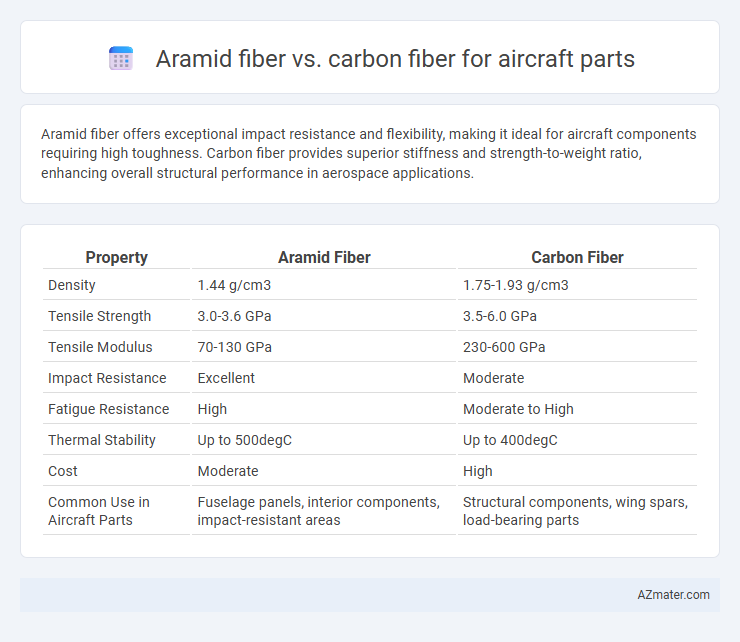Aramid fiber offers exceptional impact resistance and flexibility, making it ideal for aircraft components requiring high toughness. Carbon fiber provides superior stiffness and strength-to-weight ratio, enhancing overall structural performance in aerospace applications.
Table of Comparison
| Property | Aramid Fiber | Carbon Fiber |
|---|---|---|
| Density | 1.44 g/cm3 | 1.75-1.93 g/cm3 |
| Tensile Strength | 3.0-3.6 GPa | 3.5-6.0 GPa |
| Tensile Modulus | 70-130 GPa | 230-600 GPa |
| Impact Resistance | Excellent | Moderate |
| Fatigue Resistance | High | Moderate to High |
| Thermal Stability | Up to 500degC | Up to 400degC |
| Cost | Moderate | High |
| Common Use in Aircraft Parts | Fuselage panels, interior components, impact-resistant areas | Structural components, wing spars, load-bearing parts |
Introduction to Advanced Fibers in Aviation
Aramid fiber and carbon fiber are two advanced composite materials extensively used in aircraft parts due to their exceptional strength-to-weight ratios and durability. Aramid fibers, such as Kevlar, offer superior impact resistance and flexibility, making them ideal for components requiring toughness and energy absorption. Carbon fibers provide higher stiffness and tensile strength, which improve structural integrity and fuel efficiency in aerospace applications.
Overview of Aramid Fiber Properties
Aramid fibers exhibit exceptional tensile strength and impact resistance, making them ideal for aircraft components that require durability and lightweight performance. Their high resistance to heat and chemical degradation enhances structural integrity under high-stress conditions typical in aerospace environments. Compared to carbon fiber, aramid fibers provide superior toughness and energy absorption, crucial for impact-critical parts in aircraft design.
Overview of Carbon Fiber Properties
Carbon fiber offers exceptional strength-to-weight ratio, high stiffness, and excellent fatigue resistance, making it ideal for aircraft parts requiring durability and lightweight performance. Its thermal stability and resistance to corrosion enhance longevity in harsh aerospace environments. Compared to aramid fiber, carbon fiber provides superior tensile strength and rigidity, critical for structural components in advanced aircraft design.
Weight and Strength Comparison
Aramid fiber exhibits high tensile strength and exceptional impact resistance while maintaining low density, making it ideal for aircraft components requiring flexibility and damage tolerance. Carbon fiber offers superior stiffness and higher strength-to-weight ratio, resulting in lighter parts with enhanced structural rigidity critical for aerospace applications. The combination of carbon fiber's stiffness and aramid fiber's toughness often optimizes performance in aircraft parts where both weight reduction and strength are essential.
Durability and Fatigue Resistance
Aramid fiber offers superior impact resistance and excellent fatigue resistance, making it highly durable under cyclic loading conditions typical in aircraft parts. Carbon fiber provides exceptional stiffness and high tensile strength but can exhibit lower fatigue resistance compared to aramid under repeated stress. Selecting aramid fiber ensures enhanced durability for components subjected to fluctuating loads, while carbon fiber excels where stiffness and weight reduction are prioritized.
Thermal and Chemical Resistance
Aramid fiber exhibits superior thermal stability with a decomposition temperature around 500degC, making it highly resistant to heat in aircraft applications. Carbon fiber offers exceptional chemical resistance against solvents and corrosive agents, maintaining structural integrity in harsh environments. Both materials provide unique advantages, with aramid fibers excelling in thermal insulation and carbon fibers ensuring durability against chemical degradation in critical aircraft components.
Cost Analysis for Aircraft Manufacturing
Aramid fiber typically offers a lower material cost compared to carbon fiber, making it a cost-effective option for non-structural aircraft parts where impact resistance is crucial. Carbon fiber, while more expensive, provides superior strength-to-weight ratio and stiffness, justifying its higher price for critical structural components that enhance overall fuel efficiency and performance. Manufacturers often balance cost and performance by using aramid fibers in areas requiring toughness and carbon fibers in load-bearing sections to optimize aircraft manufacturing budgets.
Common Applications in Aircraft Parts
Aramid fiber, known for its exceptional impact resistance and lightweight properties, is commonly used in aircraft components such as interior panels, cargo liners, and engine nacelles to enhance durability and reduce weight. Carbon fiber, characterized by its high stiffness and tensile strength, is extensively applied in primary structural parts like fuselage frames, wing spars, and control surfaces to improve overall aircraft performance and fuel efficiency. Both materials complement each other in aircraft construction, with carbon fiber providing rigidity and aramid fiber offering superior toughness in non-structural components.
Safety and Maintenance Considerations
Aramid fiber offers superior impact resistance and energy absorption, making it ideal for aircraft parts requiring enhanced safety against bird strikes and debris. Carbon fiber provides high stiffness and fatigue resistance but can be prone to brittle failure, necessitating more rigorous inspection protocols. Maintenance considerations favor aramid composites for their toughness and damage tolerance, while carbon fiber components require advanced nondestructive testing to detect internal delamination and micro-cracks.
Future Trends in Aircraft Composite Materials
Aramid fiber and carbon fiber remain critical in the evolution of aircraft composite materials, with ongoing advancements emphasizing enhanced strength-to-weight ratios and improved fatigue resistance. Future trends indicate a growing integration of hybrid composites combining aramid and carbon fibers to optimize durability and impact tolerance in critical aircraft components. Innovations in nanotechnology and resin matrix formulations are expected to further boost performance, sustainability, and cost-efficiency in aerospace manufacturing.

Infographic: Aramid fiber vs Carbon fiber for Aircraft part
 azmater.com
azmater.com